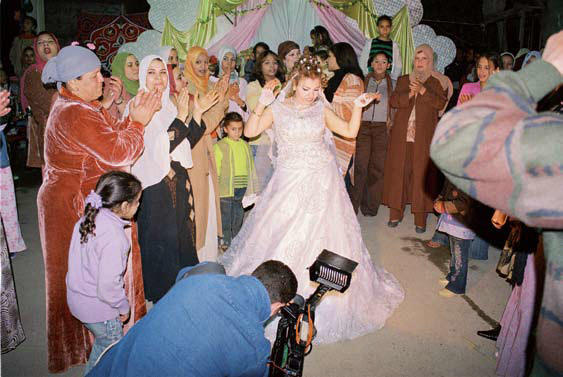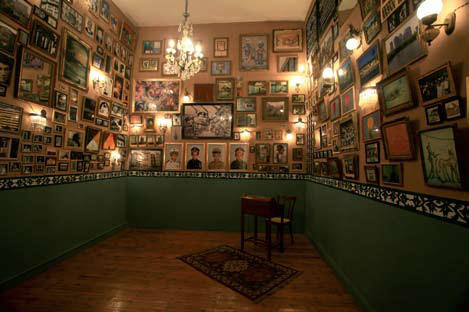
Courtesy of the artist
Cairo
PhotoCairo 4: The Long Shortcut
Various venues
December 17, 2008–January 12, 2009
When are informal modes of operation and self-styled systems of production more arduous and exhausting than the official channels they seek to circumvent? When does direct and efficient action start to seem like running in circles? When do shortcuts become longer and more taxing journeys? These were some of the questions at play during Photocairo4, subtitled ‘the long shortcut.’
Cairo’s first arts festival devoted exclusively to photography, video, and film has been around since 2002, and its roots run even deeper, to the shortlived but legendary downtown Nitaq Festival. As in past years, the fourth edition coincided with the Cairo Biennale, and to see them side by side was an exercise in understanding how the Egyptian capital’s independent art scene has trounced its bigger, betterfunded, government-sponsored rival. But while a certain competitive streak was evident, PhotoCairo4 was also an occasion for reflection and critical reassessment.
Curated by Edit Molnar and Aleya Hamza, the general director and in-house curator, respectively, of the Contemporary Image Collective (CIC), which organized this year’s festival, ‘The Long Shortcut’ featured the work of twenty-two artists from thirteen countries, with sixteen curators, scholars, graphic designers, and editors participating in the festival’s parallel program of events. Half of the projects on view were specifically commissioned for the festival.
The exhibition portion of PhotoCairo4 was threaded through four locations in downtown Cairo, with a fifth hosting two symposia like bookends for the event. In many cases, the exhibition required viewers to physically navigate the same terrain that the artists were considering conceptually and aesthetically in their work. The curatorial gestures of Hamza and Molnar played with resonance, whereby disparate works reverberated common themes and strategies — the shifting iconography of Egyptian nationalism; the decentralization of Cairo and the prospects of regeneration in the downtown district; censorship; cinema; and the poetics of daily life in times of political crisis. In some respects, the ambitions of PhotoCairo4, and the issues it set out to tackle, were more impressive than the works produced. Many of the new projects showed promise, but they also betrayed weaknesses, particularly with regard to form and a tendency to pound certain themes and formats, such as the archive, that have already been beaten to death.
Hala Elkoussy’s room-size installation of some three hundred images and objects, for example, entitled On red nails, palm trees and other icons, offered a sentient, seductive take on the archive. The artist collected old photographs and personal effects and placed them in a gorgeous but intentionally dilapidated setting, replete with retro furniture, plush curtains, and crystal lighting fixtures. The idea was to create a record of the things that downtown denizens cherish — images of young soldiers, film stars, sexy singers, postcards, loved ones, children’s playing cards — but by merely presenting rather deeply exploring the material, the piece risked fetishizing the vintage (to borrow a phrase that two of Elkoussy’s fellow Cairene artists, Hassan Khan and Sherif El-Azma, are fond of using). Elkoussy’s cache of stuff had potential, but her treatment of it — or her pathway through it to a more meaningful point of her own — needed further development.

Photo by Tarek Hefny. Courtesy of the artist
Similarly, Maha Maamoun’s single-channel video, Domestic Tourism II, considered the ways in which the Pyramids have been portrayed over decades in Egyptian cinema, and how, as tourist icons, they have shifted from emblems of a civilization’s achievements to ominous signs of foreboding, a backdrop to crimes, tragedies, and disaster scenarios. Again, fabulous material, but by simply stringing together excerpts from existing films, the artist’s intervention remained shallow (a cozy sofa in front of the screen didn’t make the extreme length of the work any more palatable).
Further along were single-channel videos by Raed Yassin and Mohamed Allam and a video installation by Ala’ Younis (with two great older pieces by Babak Afrassiabi and Hassan Khan). Like Maamoun’s work, Yassin’s twelve-minute loop, The New Film, presented a succession of film scenes. But Yassin’s rhythm was swifter, his editing eye sharper, and his incisions into the body of Egyptian cinema more precise. He raked through some five hundred films and came up with a pattern of visual and verbal tics — the ubiquitous image of President Hosni Mubarak in crime capers that inevitably pause in Cairo police stations; the common vocabulary of insults traded between male characters; the expressions of power, aggression, and fear that have shaped and reshaped a nation’s psyche through its cinematic output.
Equally self-contained, Allam’s seven-minute video, A Stream of Holy Words, featured a screen divided horizontally. On top was the text of a jumbled argument, flashing like stylized supertitles in English and Arabic. On the bottom was a young man’s face, cropped beneath the nose, voicing the altercation that appears typed out above. As if the Egyptian body politic were a madman muttering to himself, the bifurcated face ranted about the weight of history, the fading relevance of heritage, and the role of religion, all while proposing and rejecting, articulating and confusing, various positions on the margins of mainstream society.
Ala’ Younis’s installation Nefertiti delved into the artist’s discovery in a Cairo marketplace of hundreds of locally produced Nefertiti sewing machines, all discarded in a kind of industrial graveyard. The piece consisted of five of the machines, each displayed like a precious object on a white pedestal, alongside a video that narrated the history of the contraption and personal stories of those who used it, fixed it, and eventually rejected it. The Nefertiti, developed after the 1952 revolution as part of an effort to nationalize Egyptian industries, was groovy, curvaceous, and intended to empower women — but the machine only reinforced the notion that women were confined to the domestic sphere and, moreover, suffered serious design flaws and mechanical failures. The specificity of the subject, the skill with which Younis kept nostalgia and critique in check, and the artfulness with which she used a random household product to synthesize ideas about pride, loyalty, and disappointment (along with a predilection for repair and reassembly that seemed entirely characteristic of contemporary life in the Egyptian capital) made Nefertiti one of the highlights of PhotoCairo4.